Assessing Current Seismic Hazards in Irpinia Forty Years after the 1980 Earthquake: Merging Historical Seismicity and Satellite Data about Recent Ground Movements
Abstract
1. Introduction
2. Relationship between Strain Rate and Earthquakes
3. Stain Rate in Irpinia
4. The Historical Record of Earthquakes in Irpinia
- (a)
- an area of genuinely low long-term seismicity;
- (b)
- either the incompleteness or a too-short time-span of the earthquake catalog;
- (c)
- a quiescent period in an area characterized by temporal clustering, followed by a long recurrence interval [31].
5. Conclusions
- the short time gap between strong events in Irpinia during the 1694–1732 and 1930–1980 periods is linked to periods of continuous high strain rates;
- instead, the long seismic gap (a lack of strong seismicity) between 1732 and 1930 could have originated from a strain rate drop after the 1732 earthquake.
Author Contributions
Funding
Data Availability Statement
Conflicts of Interest
References
- Farolfi, G.; Piombino, A.; Catani, F. Fusion of GNSS and Satellite Radar Interferometry: Determination of 3D Fine-Scale Map of Present-Day Surface Displacements in Italy as Expressions of Geodynamic Processes. Remote. Sens. 2019, 11, 394. [Google Scholar] [CrossRef]
- Farolfi, G.; Bianchini, S.; Casagli, N. Integration of GNSS and satellite InSAR data: Derivation of fine-scale vertical surface motion maps of Po Plain, Northern Apennines and Southern Alps, Italy. IEEE Trans. Geosci. Remote. Sens. 2019, 57, 319–328. [Google Scholar] [CrossRef]
- Farolfi, G.; Del Soldato, M.; Bianchini, S.; Casagli, N. A procedure to use GNSS data to calibrate satellite PSI data for the study of subsidence: An example from the north-western Adriatic coast (Italy). Eur. J. Remote. Sens. 2019, 52, 54–63. [Google Scholar] [CrossRef]
- Farolfi, G.; Del Ventisette, C. Contemporary crustal velocity field in Alpine Mediterranean area of Italy from new geodetic data. GPS Solut. 2015, 20, 715–722. [Google Scholar] [CrossRef]
- D’Agostino, N.; Jackson, J.A.; Dramis, F.; Funiciello, R. Interactions between mantle upwelling, drainage evolution and active normal faulting: An example from the central Apennines (Italy). Geophys. J. Int. 2001, 147, 475–497. [Google Scholar] [CrossRef]
- Italiano, F.; Martelli, M.; Martinelli, G.; Nucci, M. Geochemical evidence of melt intrusions along lithospheric faults of the Southern Apennines, Italy: Geodynamic and seismogenic implications. J. Geophys. Res. 2000, 105, 13569–13578. [Google Scholar] [CrossRef]
- Di Luccio, F.; Chiodini, G.; Caliro, S.; Cardellini, C.; Convertito, V.; Pino, N.A.; Tolomei, C.; Ventura, G. Seismic signature of active intrusions in mountain chains. Sci. Adv. 2018, 4, e1701825. [Google Scholar] [CrossRef]
- Chiodini, G.; Cardellini, C.; Di Luccio, F.; Selva, J.; Frondini, F.; Caliro, S.; Rosiello, A.G.; Beddini, G.; Ventura, G. Correlation between tectonic CO2 Earth degassing and seismicity is revealed by a 10-year record in the Apennines, Italy. Sci. Adv. 2020, 6, 35. [Google Scholar] [CrossRef] [PubMed]
- Doglioni, C.; Harabaglia, P.; Martinelli, G.; Mongelli, F.; Zito, G. A geodynamic model of the Southern Apennines accretionary prism. Terra Nova 1996, 8, 540–547. [Google Scholar] [CrossRef]
- Rosenbaum, G.; Lister, G.S. Neogene and Quaternary rollback evolution of the Tyrrhenian Sea, the Apennines, and the Sicilian Maghrebides. Tectonics 2004, 23, TC1013. [Google Scholar] [CrossRef]
- Di Bucci, D.; Corrado, S.; Naso, G. Active faults at the boundary between Central and Southern Apennines (Isernia, Italy). Tectonophysics 2002, 359, 47–63. [Google Scholar] [CrossRef]
- Riguzzi, F.; Crespi, M.; Devoti, R.; Doglioni, C.; Pietrantonio, G.; Pisani, A.R. Geodetic strain rate and earthquake size: New clues for seismic hazard studies. Phys. Earth Planet. Inter. 2012, 206, 67–75. [Google Scholar] [CrossRef]
- Devoti, R.; Esposito, A.; Pietrantonio, G.; Pisani, A.R.; Riguzzi, F. Evidence of large scale deformation patterns from GPS data in the Italian subduction boundary. Earth Planet. Sci. Lett. 2011, 311, 230–241. [Google Scholar] [CrossRef]
- Palano, M. On the present-day crustal stress, strain-rate fields and mantle anisotropy pattern of Italy. Geophys. J. Int. 2015, 200, 969–985. [Google Scholar] [CrossRef]
- Montone, P.; Mariucci, M.T. P-wave velocity, density, and vertical stress magnitude along the crustal Po Plain (Northern Italy) from sonic log drilling data. Pure Appl. Geophys. 2015, 172, 1547–1561. [Google Scholar] [CrossRef]
- Mastrolembo, B.; Caporali, A. Stress and strain-rate fields: A comparative analysis for the Italian territory. Boll. Geofis. Teor. Appl. 2017, 58, 265–284. [Google Scholar]
- Farolfi, G.; Keir, D.; Corti, G.; Casagli, N. Spatial forecasting of seismicity provided from Earth observation by space satellite technology. Sci. Rep. 2020, 10, 1–7. [Google Scholar] [CrossRef] [PubMed]
- Dermanis, A.; Livieratos, E. Applications of deformation analysis in geodesy and geodynamics. Rev. Geophys. 1983, 21, 41–50. [Google Scholar] [CrossRef]
- Farolfi, G.; Del Ventisette, C. Strain rates in the Alpine Mediterranean region: Insights from advanced techniques of data processing. GPS Solut. 2017, 21, 1027–1036. [Google Scholar] [CrossRef]
- INGV—Italian Seismic Bulletin. Available online: http://terremoti.ingv.it/en/bsi (accessed on 30 January 2021).
- Markušic, S.; Stanko, D.; Korbar, T.; Belic, N.; Penava, D.; Kordic, B. The Zagreb (Croatia) M5.5 Earthquake on 22 March 2020. Geosciences 2020, 10, 252. [Google Scholar] [CrossRef]
- Galli, P.; Peronace, E. New paleoseismic data from the Irpinia Fault. A different seismogenic perspective for southern Apennines (Italy). Earth Sci. Rev. 2014, 136, 175–201. [Google Scholar] [CrossRef]
- Pino, N.A.; Palombo, B.; Ventura, G.; Perniola, B.; Ferrari, G. Waveform modeling of historical seismograms of the 1930 Irpinia earthquake provides insight on ‘‘blind’’ faulting in Southern Apennines (Italy). J. Geophys. Res. 2008, 113, B05303. [Google Scholar] [CrossRef]
- Serva, L.; Esposito, E.; Guerrieri, L.; Porfido, S.; Vittori, E.; Comercia, V. Environmental effects from five his-torical earthquakes in southern Apennines (Italy) and macroseismic intensity assessment: Contribution to IN-QUA EEE Scale Project. Quat. Int. 2007, 173, 30–44. [Google Scholar] [CrossRef]
- Vannoli, P.; Bernardi, F.; Palombo, B.; Vannucci, G.; Console, R.; Ferrari, G. New constraints shed light on strike-slip faulting beneath the southern Apennines (Italy): The 21 August 1962 Irpinia multiple earthquakes. Tectonophysics 2016, 691, 375–384. [Google Scholar] [CrossRef]
- Rovida, A.; Locati, M.; Camassi, R.; Lolli, B.; Gasperini, P.; Antonucci, A. Italian Parametric Earthquake Catalogue (CPTI15); Version 3.0; Istituto Nazionale di Geofisica e Vulcanologia (INGV): Rome, Italy, 2021. [Google Scholar] [CrossRef]
- Rovida, A.; Locati, M.; Camassi, R.; Lolli, B.; Gasperini, P. The Italian earthquake catalogue CPTI15. Bull. Earthq. Eng. 2020, 18, 2953–2984. [Google Scholar] [CrossRef]
- Rovida, A.; Locati, M.; Antonucci, A.; Camassi, R. (Eds.) Italian Archive of Historical Earthquake Data (ASMI); Istituto Nazionale di Geofisica e Vulcanologia (INGV): Rome, Italy, 2017. [Google Scholar] [CrossRef]
- Galli, P. Roman to Middle Age Earthquakes Sourced by the 1980 Irpinia Fault: Historical, Archaeoseismological, and Paleoseismological Hints. Geosciences 2020, 10, 286. [Google Scholar] [CrossRef]
- Fracassi, U.; Valensise, G. Unveiling the Sources of the Catastrophic 1456 Multiple Earthquake: Hints to an Unexplored Tectonic Mechanism in Southern Italy. Bull. Seismol. Soc. Am. 2007, 97, 725–748. [Google Scholar] [CrossRef]
- Marco, S.; Stein, M.; Agnon, A.; Ron, H. Long-term earthquake clustering: A 50,000 year paleoseimic record in the Dead Sea Graben. J. Geophys. Res. 1996, 101, 6179–6191. [Google Scholar] [CrossRef]
- Stucchi, M.; Meletti, C.; Montaldo, V.; Akinci, A.; Faccioli, E.; Gasperini, P.; Malagnini, L.; Valensise, G. Pericolosità Sismica di Riferimento per Il Territorio Nazionale MPS04; Data Set; Istituto Nazionale di Geofisica e Vulcanologia (INGV): Rome, Italy, 2004. [Google Scholar] [CrossRef]
- Papanikolaοu, I.D.; Roberts, G. Clustering and anticlustering in the Southern Apennines as evidenced from geological fault slip-rate seismic hazard maps and the historical record. In Proceedings of the 2nd INQUA-IGCP-567 International Workshop on Active Tectonics, Earthquake Geology, Archaeology and Engineering, Corinth, Greece, 19–24 September 2011; pp. 174–177. [Google Scholar]
- Tondi, E.; Cello, G. Spatiotemporal evolution of the Central Apennines fault system (Italy). J. Geodyn. 2003, 36, 113–128. [Google Scholar] [CrossRef]
- Viti, M.; Mantovani, E.; Cenni, N.; Vannucchi, A. Interaction of seismic sources in the Apennine belt. Phys. Chem. Earth 2013, 63, 25–35. [Google Scholar] [CrossRef]
- Bonini, M.; Corti, G.; Delle Donne, D.; Sani, F.; Piccardi, L.; Vannucci, G.; Genco, R.; Martelli, L.; Ripepe, M. Seismic sources and stress transfer interaction among axial normal faults and external thrust fronts in the Northern Apennines (Italy): A working hypothesis based on the 1916–1920 time–space cluster of earthquakes. Tectonophysics 2016, 680, 67–89. [Google Scholar] [CrossRef]
- Stein, R.S.; King, G.C.P.; Lin, J. Change in failure stress on the southern San Andreas fault system caused by the 1992 magnitude 5 7.4 Landers earthquake. Science 1992, 258, 1328–1332. [Google Scholar] [CrossRef] [PubMed]
- Mantovani, E.; Viti, M.; Cenni, N.; Babbuccia, D.; Tamburelli, C.; Baglione, M.; D’Intinosante, V. Seismotectonics and present seismic hazard in the Tuscany–Romagna–Marche–Umbria Apennines (Italy). J. Geodyn. 2015, 89, 1–14. [Google Scholar] [CrossRef]
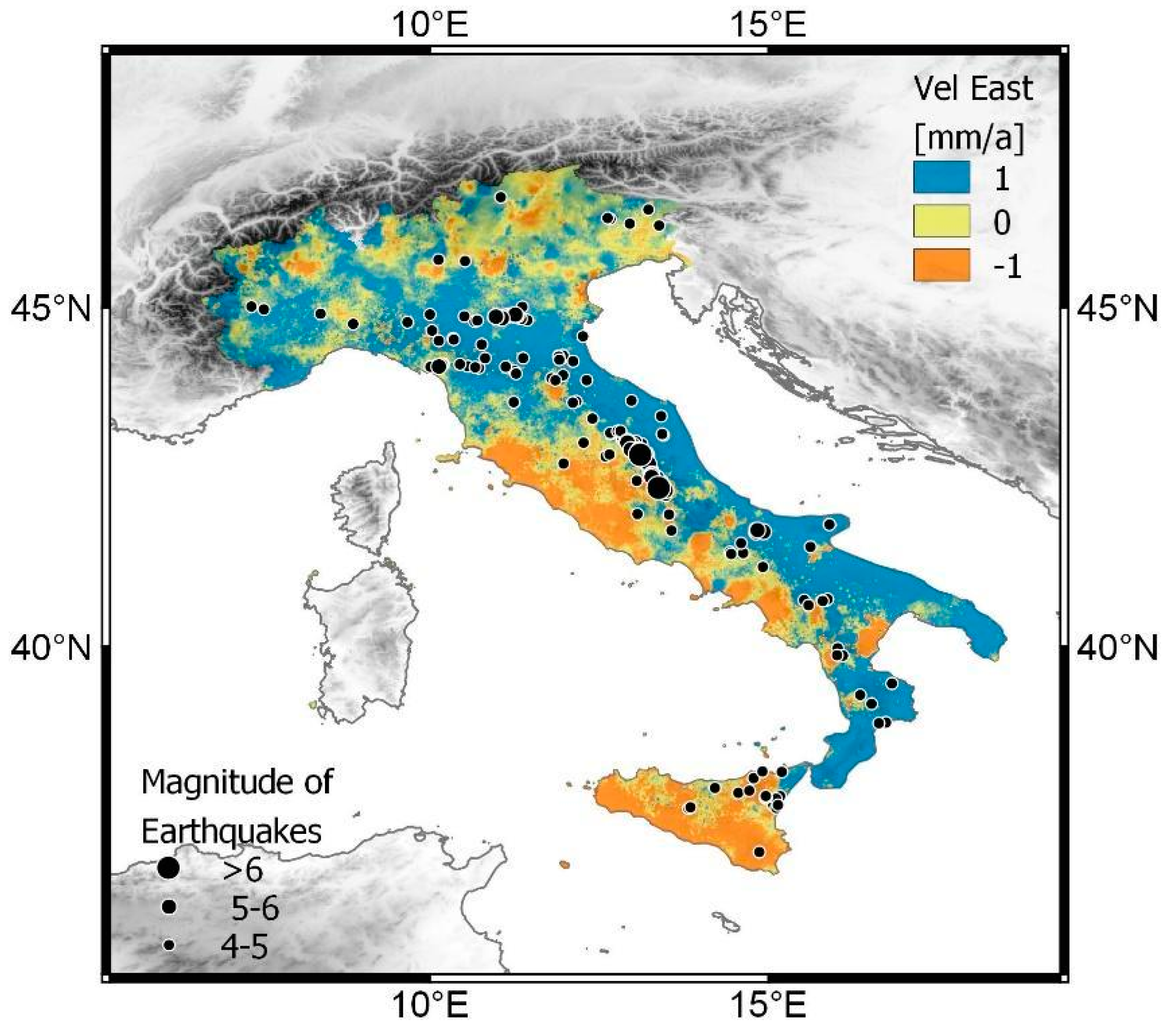
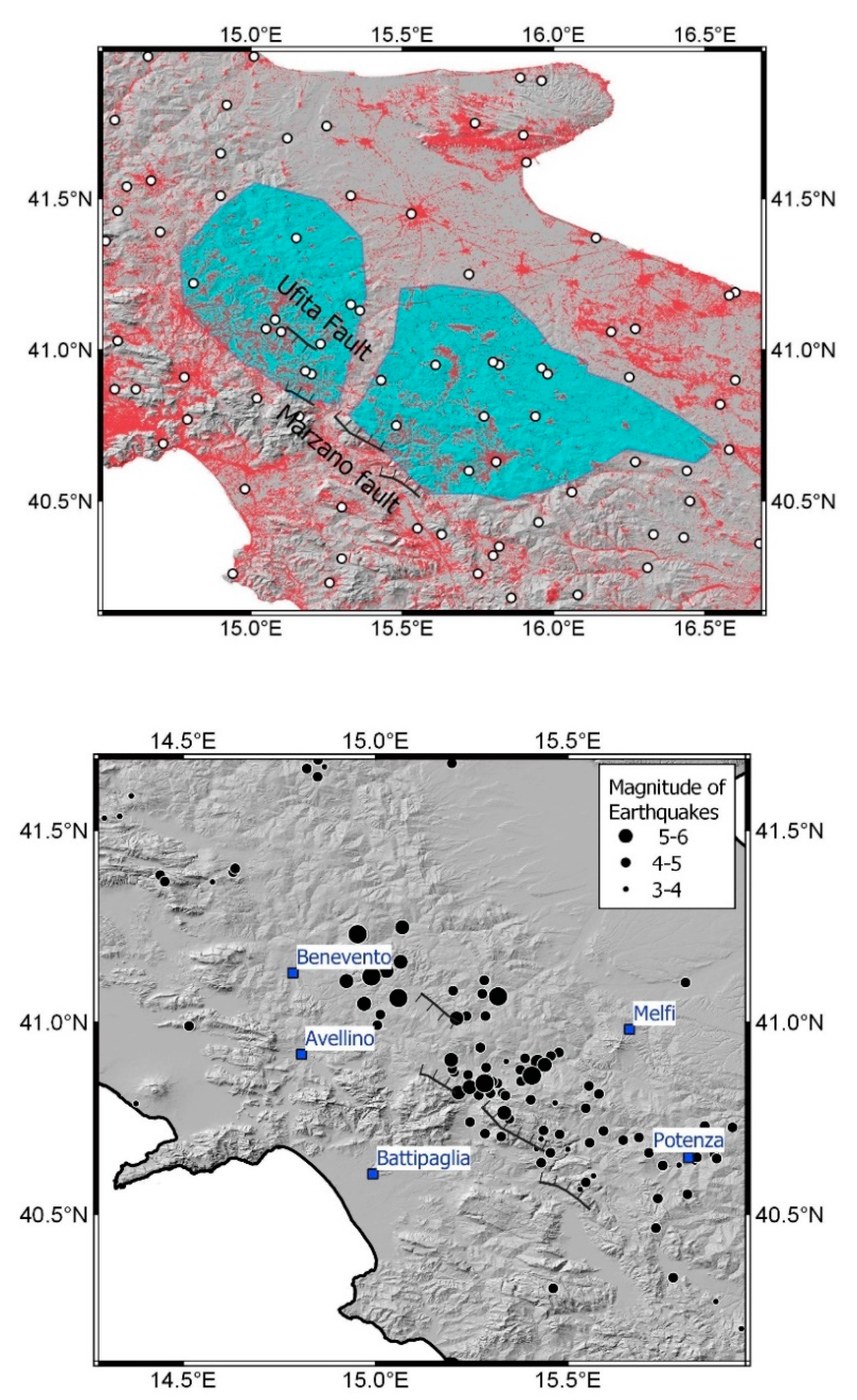
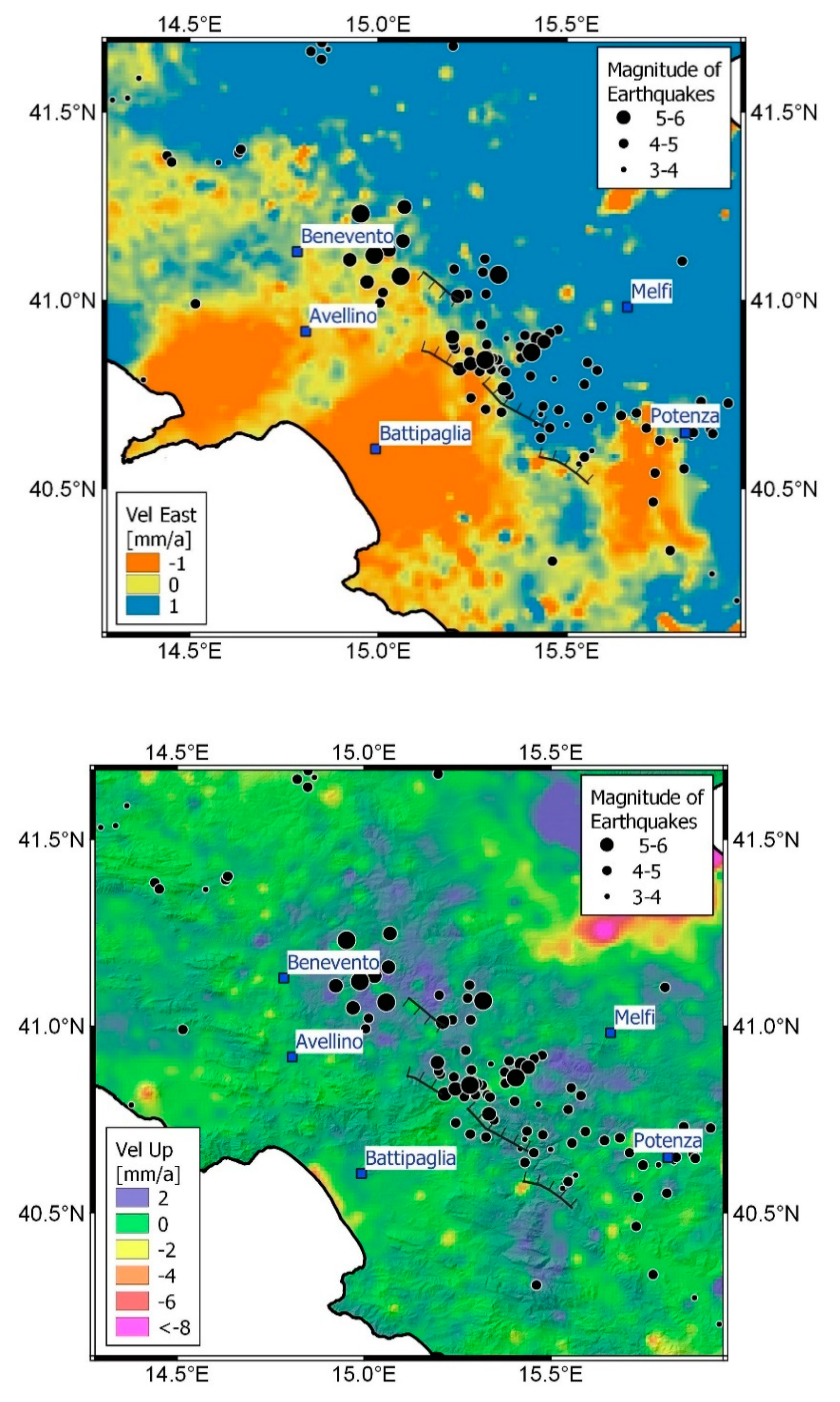
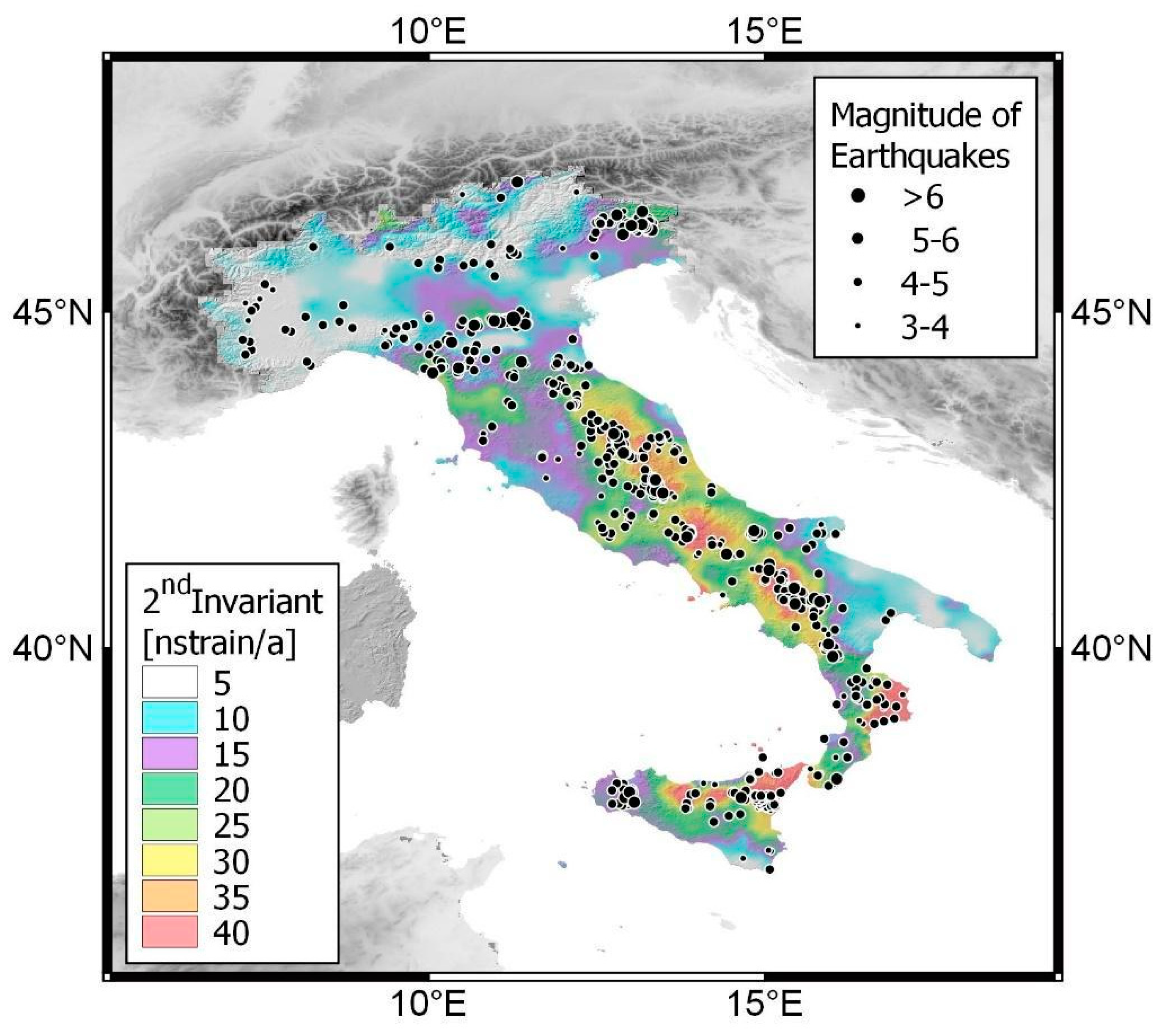
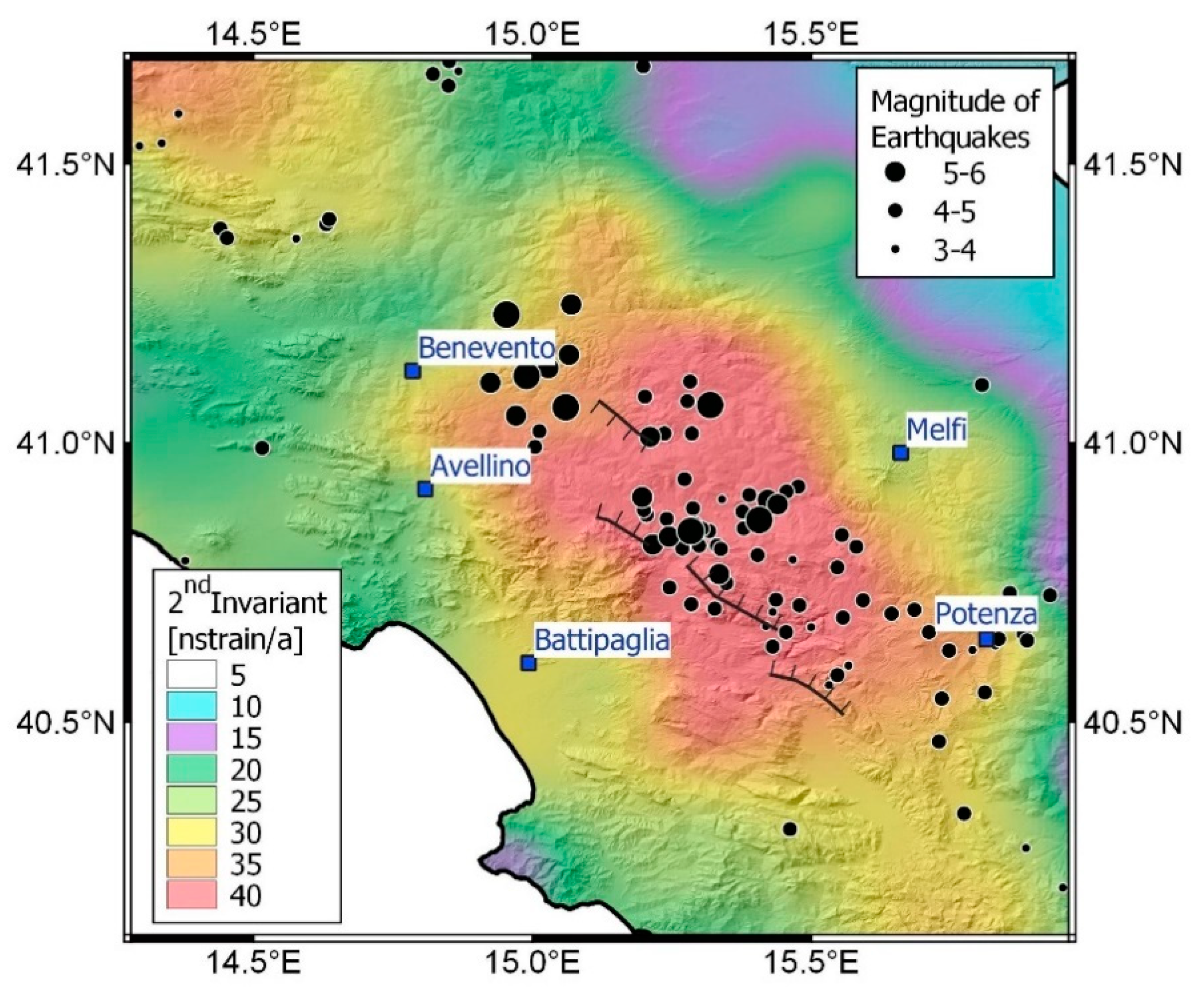
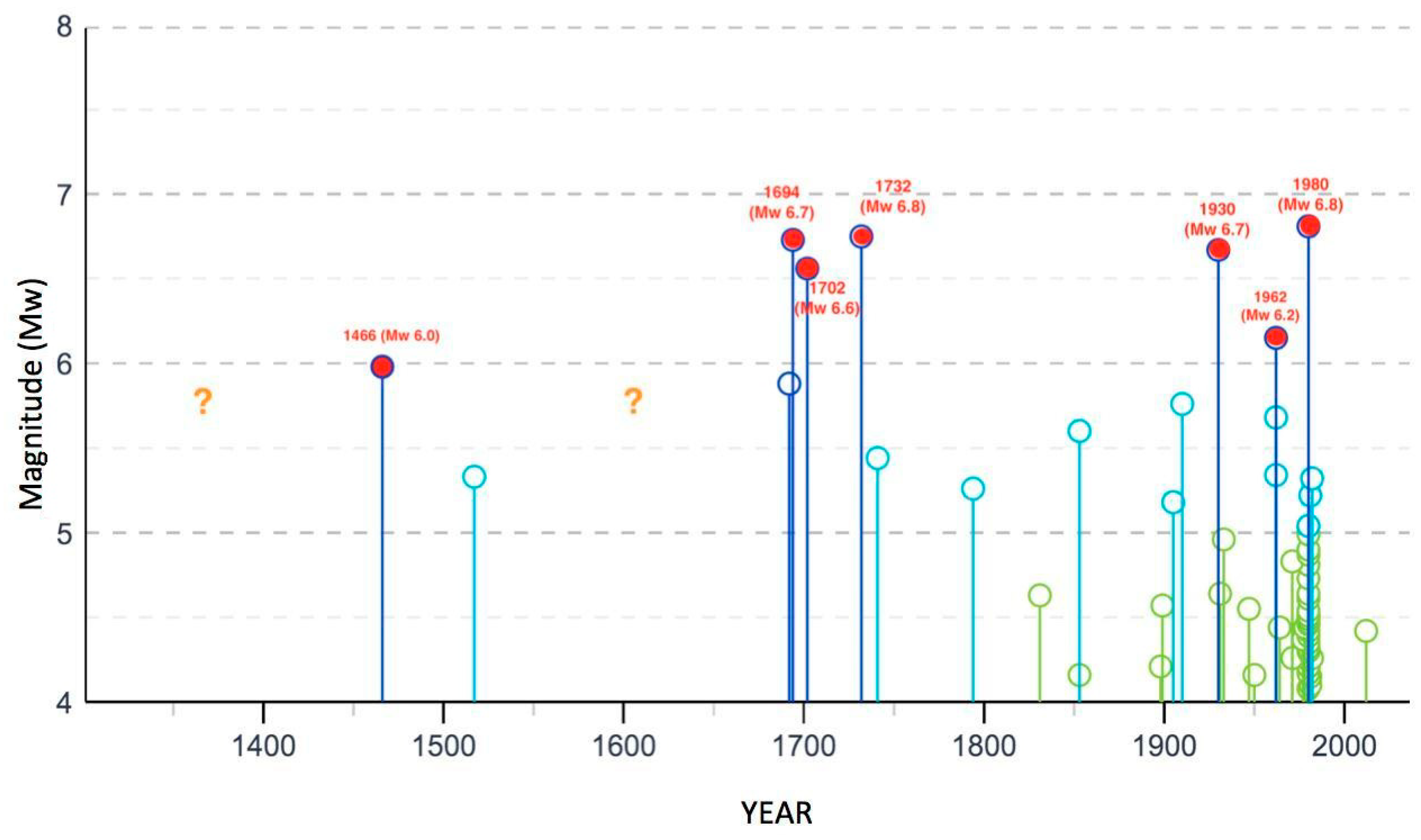
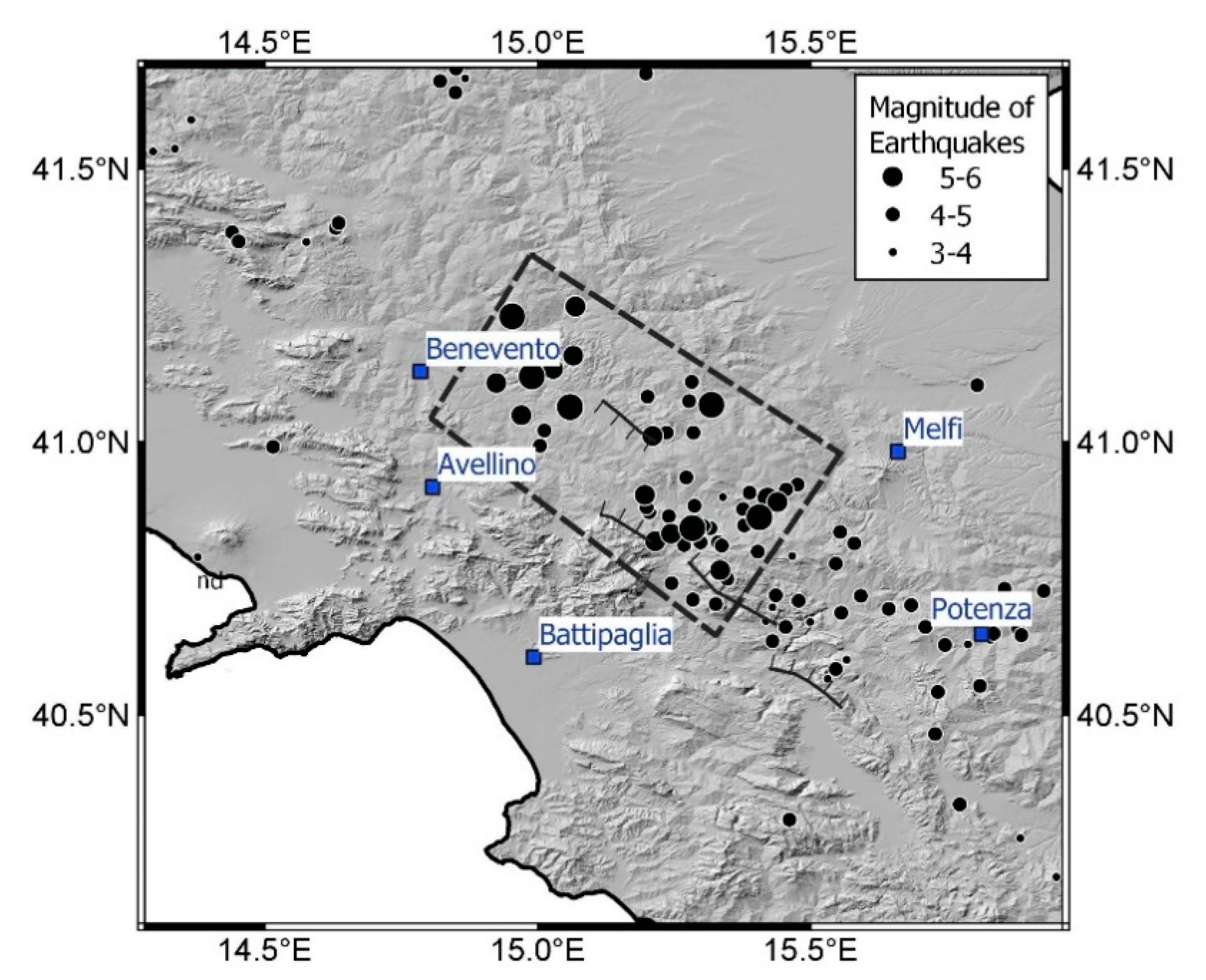
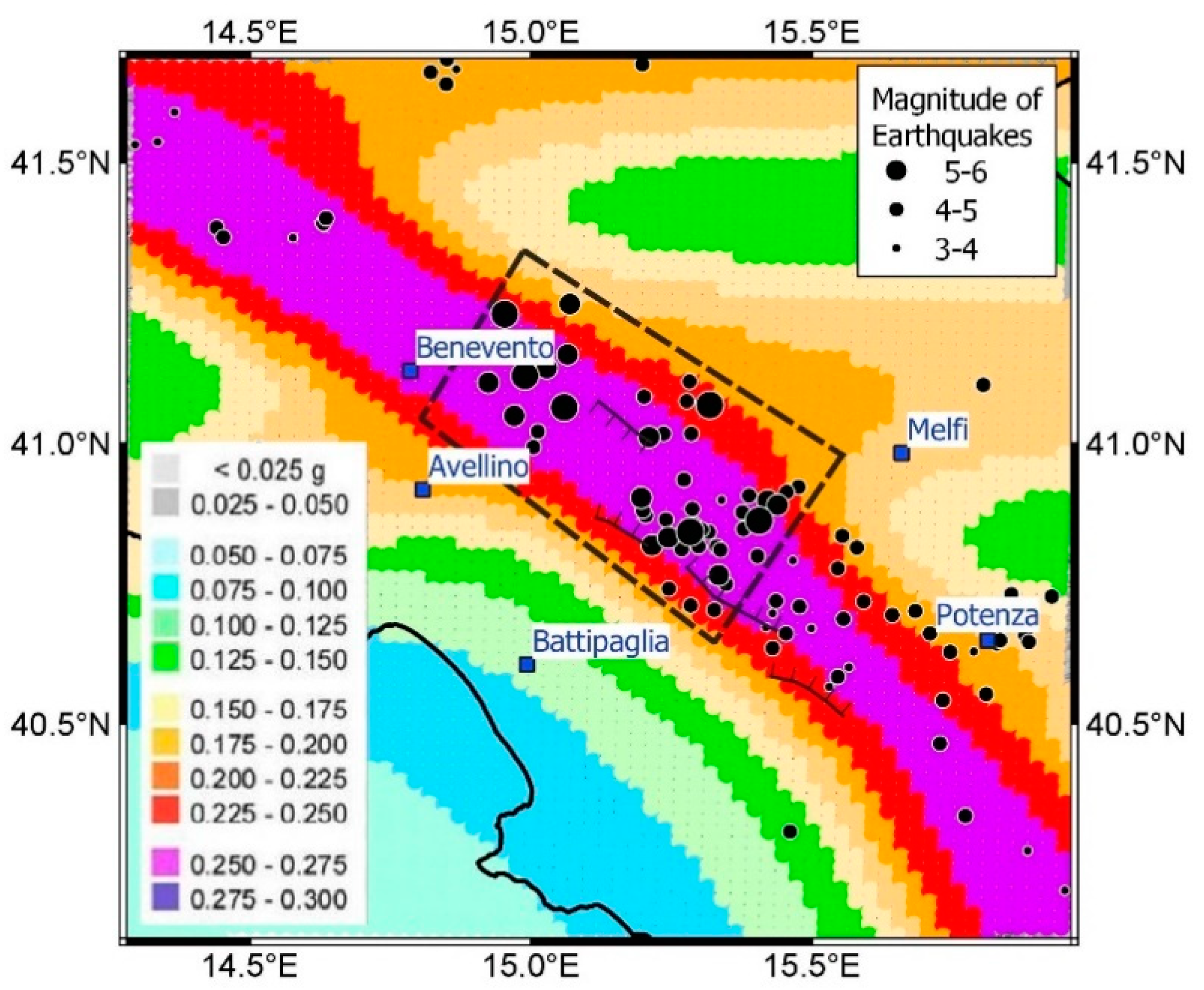
| Year Mo Da | Epicentral Area | Lat | Lon | Io (MCS) | Mw |
|---|---|---|---|---|---|
| 1466 01 15 | Irpinia–Basilicata | 40.765 | 15.334 | 8–9 | 6.0 |
| 1517 03 29 | Irpinia | 41.011 | 15.210 | 7–8 | 5.3 |
| 1692 03 04 | Irpinia | 40.903 | 15.196 | 8 | 5.9 |
| 1694 09 08 | Irpinia–Basilicata | 40.862 | 15.406 | 10 | 6.7 |
| 1702 03 14 | Sannio–Irpinia | 41.120 | 14.989 | 10 | 6.6 |
| 1732 11 29 | Irpinia | 41.064 | 15.059 | 10–11 | 6.8 |
| 1741 08 06 | Irpinia | 41.049 | 14.970 | 7–8 | 5.4 |
| 1794 06 12 | Irpinia | 41.108 | 14.924 | 7 | 5.3 |
| 1853 04 09 | Irpinia | 40.818 | 15.215 | 8 | 5.6 |
| 1905 11 26 | Irpinia | 41.134 | 15.028 | 7–8 | 5.2 |
| 1910 06 07 | Irpinia–Basilicata | 40.898 | 15.421 | 8 | 5.8 |
| 1930 07 23 | Irpinia | 41.068 | 15.318 | 10 | 6.7 |
| 1962 08 21 | Irpinia | 41.248 | 15.069 | 5.7 | |
| 1962 08 21 | Irpinia | 41.230 | 14.953 | 9 | 6.2 |
| 1962 08 21 | Irpinia | 41.158 | 15.065 | 5.3 | |
| 1980 11 23 | Irpinia–Basilicata | 40.842 | 15.283 | 10 | 6.8 |
| 1980 11 24 | Irpinia–Basilicata | 40.811 | 15.268 | 5.0 | |
| 1981 01 16 | Irpinia–Basilicata | 40.890 | 15.439 | 5.2 | |
| 1982 08 15 | Irpinia | 40.832 | 15.244 | 6 | 5.3 |
Publisher’s Note: MDPI stays neutral with regard to jurisdictional claims in published maps and institutional affiliations. |
© 2021 by the authors. Licensee MDPI, Basel, Switzerland. This article is an open access article distributed under the terms and conditions of the Creative Commons Attribution (CC BY) license (https://creativecommons.org/licenses/by/4.0/).
Share and Cite
Piombino, A.; Bernardini, F.; Farolfi, G. Assessing Current Seismic Hazards in Irpinia Forty Years after the 1980 Earthquake: Merging Historical Seismicity and Satellite Data about Recent Ground Movements. Geosciences 2021, 11, 168. https://doi.org/10.3390/geosciences11040168
Piombino A, Bernardini F, Farolfi G. Assessing Current Seismic Hazards in Irpinia Forty Years after the 1980 Earthquake: Merging Historical Seismicity and Satellite Data about Recent Ground Movements. Geosciences. 2021; 11(4):168. https://doi.org/10.3390/geosciences11040168
Chicago/Turabian StylePiombino, Aldo, Filippo Bernardini, and Gregorio Farolfi. 2021. "Assessing Current Seismic Hazards in Irpinia Forty Years after the 1980 Earthquake: Merging Historical Seismicity and Satellite Data about Recent Ground Movements" Geosciences 11, no. 4: 168. https://doi.org/10.3390/geosciences11040168
APA StylePiombino, A., Bernardini, F., & Farolfi, G. (2021). Assessing Current Seismic Hazards in Irpinia Forty Years after the 1980 Earthquake: Merging Historical Seismicity and Satellite Data about Recent Ground Movements. Geosciences, 11(4), 168. https://doi.org/10.3390/geosciences11040168








